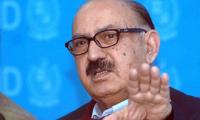History bears testimony to the fact that education is the most sustained and efficient means of progression in society. Let me begin with an illustration of a simple example: a water pump pumps river water through a hosepipe with a meshwork filter at its end into a water collection tank. The river water gets filtered through the meshwork filter to remove tangible impurities and the clean output flows into the tank.
The educational system serves as the filter of society, the river as the pool of callow brains capable of advancement and the water in the collection tank as the output of the education system.
Figuratively, the design of the filter – the education system – shapes the social fabric and rational structure of society collectively. The significance of the quality of the filter is superlative to the degree that it enables society’s development of conscience. In qualitative terms, it is the quality of the filter that sets the nation’s overall threshold of acceptability of ‘right’ and ‘wrong’.
There is at present a lot of disparity in the country owing to three disperse echelons of formal education prevalent in the country: the Cambridge International Examinations, the BISE system in private schools and the BISE system in government schools.
Unequivocally, the CIE system is adjudged as the best system in the country owing to the quality of curriculum, concept-based testing methodology and international recognition. The CIE system, however, is a dream for majority of the youth in Pakistan who await the dire attention of the state either vide improvement in government schools or vide regulations for private schools, both aimed at quality enhancement.
Lack of spending on education, ghost employees, poor infrastructure and poor quality of education are cited as some of the prime bottlenecks in the state education system. However, research presents a rather different set of facts.
According to a research study by the Wilson Centre titled ‘Pakistan Education Crisis’ published in July 2016, “Pakistan’s budgeted expenditure on education amounted to $7.5 billion for the fiscal year 2016 which is more than double of the $3.5 billion education spending in 2010. This is the combined value of the four provincial budgets plus a small amount that is allocated at the federal level for higher education and schools in Islamabad. Most provinces have more than doubled their budgets since 2010 – the year in which the 18th Amendment devolved education and several other social sectors from the federal government to the provinces. Thenceforth, Khyber Pakhtunkhwa and Balochistan have nearly tripled their education budgets.
“The military budget for 2016, excluding military pensions, cost of the nuclear programme and cost of military operations in Fata, amounted to $8.2 billion which is fairly close to the $7.5 billion budgeted for education.
“There are more government teachers in Pakistan than active duty personnel in the Pakistani military, being 730,131 and 643,800 respectively. The total number of teachers in Pakistan (including private schools) also exceeds the total strength of the Pakistani military (including reservists and paramilitary), standing at 1,461,744 and 1,460,800 respectively. Astoundingly, 55 percent of government employees in KP belong to the education department while 52 percent of Balochistan government’s salaries go to education.”
From an economic perspective, the study suggests that “Pakistan’s government spends a lot on education, relative to the resources it has, however when the education budget is expressed as a percentage of its GDP, it does poorly. Pakistan has budgeted the equivalent of 2.7 percent of its GDP on education for the fiscal year 2016 while the international minimum is 4 percent. Pakistan is behind other South Asian and sub-Saharan countries when spending is expressed in these terms.
However, when analysed from an alternative viewpoint, Unesco recommends education spending in the range of 15-20 percent whereas Pakistan’s provinces spend 17-28 percent of their budgets, gesturing overspending.”
The issue then doesn’t seem to be the spending on the filters but the design of the filter. With the current modus operandi of the government education system, salaries and allowances devour the majority of the education budget, leaving behind little funding for oversight activities, infrastructure overhaul and capacity-building. With the current mechanism, even if further funds are channelled into the education system, the dilemma will remain as the system is in dire need of a structural reform.
Education now falls under the jurisdiction of the provincial governments but its responsibility from the federal government has not been completely shrugged off. The spirit of the 18th Amendment was the strengthening of the federation. To that end, parliament shall mandate the Council of Common Interests with the responsibility of devising a uniform set of educational reforms across the country which, once developed, shall be mandatorily run by provincial governments. This political will from all provinces will definitely open doors for donor funding for reforms.
Issues such as poor infrastructure, lack of facilities, ghost employees, outdated curriculums, capacity-building of teachers, lack of focus on aptitude enhancement, promotion of ICT, etc shall be fairly addressed in the structural reform process in order to design a filter that purifies the river water to an extent that is at least at par with other filtration mechanisms globally.
Let’s hope the issue is addressed by political parties in their manifestos – and eventually delivered.
The writer is a chartered accountant and a graduate of Oxford Brookes University.
Email: shahzadtahirk@gmail.com
Twitter: Shahzad_91
People stand in line up as election officials check their ballot papers during voting general election at a polling...
Women show their voter identity cards as they stand in a queue before casting their votes in Agartala. — PTIThe 18th...
Former prime minister Imran Khan. — Instagram/ imrankhan.ptiAn old saying has it that “when you dance with the...
Kashmiris in Indian illegally occupied Kashmir protesting against the Indian occupation as the forces of India looked...
A representational image showing residents walking at a wholesale market in Karachi. — AFP/FileOnce again there is...
A representational image showing late Pakistani human rights activist and Supreme Court lawyer Asma Jahangir. —...







